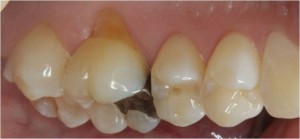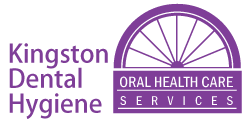Gum Recession – Know the Cause
Myth: Receding gum tissue is caused by brushing the wrong way, brushing too hard or using a toothbrush that is too hard.
Fact: Looking at the picture here you see that the gum tissue has receded (the root is exposed) on only one tooth. Common sense tells us that bushing too hard or the wrong way or with a hard brush would affect more than just one tooth.
You may have noticed receding gums yourself either visually or by experiencing sensitivity when you eat or drink something hot or cold. There are toothpastes and in-office treatments available that can be applied to these areas to relieve symptoms. When I exam my clients and find recession I want to know what CAUSED their gum recession and what action to take to STOP the process?
 Further examination may reveal one or more of the following; extra bone growing inside the lower teeth, as well as on the outside of the teeth, wearing down of the biting edges of the teeth, clicking of the TMJ(jaw joint), missing teeth or dental restorations including fillings, crowns, bridges and/or implants. There may be a scalloping of the borders of the tongue, cheek biting and possibly notching in the enamel at the gum line. Bleeding gums may be evident and periodontal pockets may be present.
Further examination may reveal one or more of the following; extra bone growing inside the lower teeth, as well as on the outside of the teeth, wearing down of the biting edges of the teeth, clicking of the TMJ(jaw joint), missing teeth or dental restorations including fillings, crowns, bridges and/or implants. There may be a scalloping of the borders of the tongue, cheek biting and possibly notching in the enamel at the gum line. Bleeding gums may be evident and periodontal pockets may be present.
Someone with one or more of these signs may also experience symptoms such as; headaches, migraines, jaw joint (TMJ) soreness as well as noises in the joint. There may be ear stuffiness, sporadic loss of hearing in one ear or both, ringing in the ears, neck pain, shoulder pain, tingling of the arm or hand on one side or both. You might be interested to discover that your receding gums, pain in your neck and sore knee just might be all be connected.
Research has proven that recession of the gum tissue is a result of an imbalanced bite caused by the muscles that are responsible for opening and closing the jaw which may also affect the muscles in the neck.
